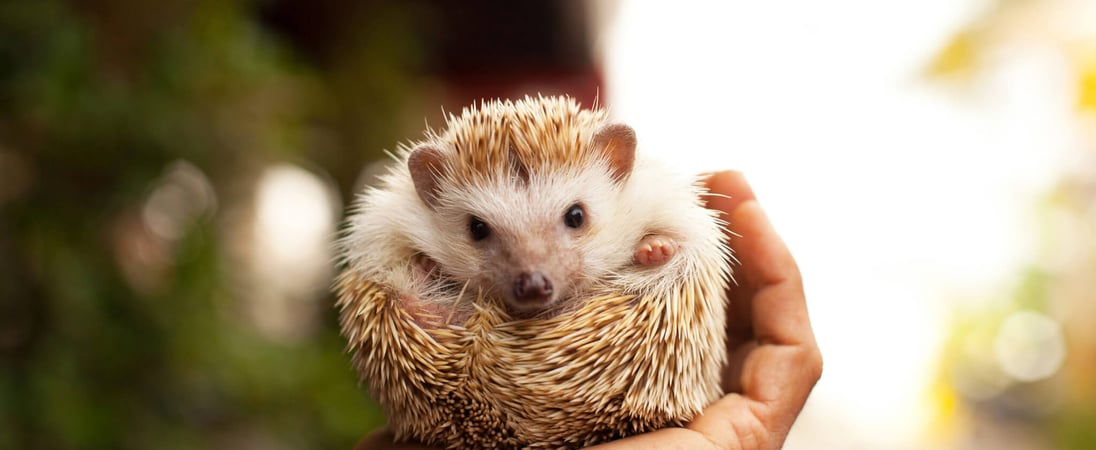
National Hedgehog Day
Small, spiny and oh-so-cute, these creatures are the unlikely gardeners of the animal kingdom, helping to keep insect populations in check and spreading seeds.
Ouch! National Hedgehog Day highlights these loveable creatures but heeds this word of warning – don’t get too close!
Yet while hedgehogs certainly know how to defend themselves, we can all still do our bit to help protect them, and what better time to start than on National Hedgehog Day…
How to Celebrate National Hedgehog Day
Celebrate National Hedgehog Day in a variety of ways, including some of these:
Help Protect Hedgehogs
Help protect these prickly yet adorable creatures. In some parts of the world, particularly Europe, hedgehog numbers are sadly declining – this appears to be due to a variety of complex factors such as habitat loss through urbanization and agriculture, food scarcity due to pesticide use, and disease caused by parasites.
Create a Hedgehog Habitat
If you’re lucky enough to have a garden – prime hedgehog habitat – then why not make it hedgehog safe?
Always check for spiny visitors before mowing your lawn and allow an escape route from your pond or water feature. Check bonfires before lighting them as these are another popular hiding place for hedgehogs and take care with netting as they can easily get tangled!
If you come across a hedgehog in need of help, keep it warm and offer it cat or dog food along with freshwater – this is much better than giving it milk and bread. You can then either take it to a local rescue center or, if it’s perked up, release it back into the wild.
Make Your Garden Hedgehog Friendly
And there are plenty of things you can do to go the extra mile and make your garden, even more, hedgehog friendly.
Each individual will have its own home range of up to 30 hectares, so hedgehog highways are especially important in urban areas – creating gaps through or tunnels under fences between your garden and your neighbors’ will ensure that hedgehogs can roam far and wide for food.
Growing a wide range of plants will increase the insect population in your garden, offering up a delicious feast for any passing hedgehog.
And you can even encourage them to settle in your garden, either by piling up some logs and leaves for a cozy nest or by building a small hedgehog home – you’ll find plenty of great instructions for these online!
Bake a Hedgehog Cake
Hedgehog cakes are very fun to bake, especially with children, and if you’re really serious about protecting the hedgehog you could even sell your cakes to fundraise for a hedgehog preservation charity!
You can also sign up for a citizen science project to help monitor numbers and some organizations and charities offer the chance to adopt a hedgehog for yourself or a loved one.
However you celebrate, it’s sure to be a spine-tacular day!
Learn Some Fascinating Facts About Hedgehogs
-
There are 14 species of hedgehog around the world
Largely concentrated in Europe, Africa, and Asia, these nocturnal and solitary creatures are most commonly found in green spaces such as gardens, woods, and parks – of course, hedges are a particularly popular haunt for these mammals, which, combined with their small snouts and piglike snuffling, is where they got their name!
-
Hedgehogs are covered in spines
These spines are actually hollow hairs stiffened by keratin. Hedgehogs use their many spines (around 5,000 when fully grown!) as a defense mechanism when under threat by rolling into a tight ball so that all the spikes point outwards.
What is less well known is that they also use them for cheese and pineapple during cocktail parties (although there is yet to be any photographic evidence of this…!).
-
Hedgehogs rely heavily on their sense of smell
They can detect food under an inch of soil and can often sense the presence of danger.
They’re omnivores, best known for snacking on creepy crawlies such as earthworms, slugs, and caterpillars, but they also eat delicacies such as mushrooms, berries, small frogs, and bird eggs. They tend to search for food at night and can travel a distance of 2-3 KMs.
-
Hedgehogs self-anoint
This seems to be connected with irregular smells or tastes making them create large quantities of frothy saliva which they then flick over their spines with their tongue (please do not disturb a hedgehog in the middle of this process, it’s like catching someone in the shower).
-
Baby hedgehogs are called hoglets
Hoglet litters are born in late spring/early summer and the young spend around a month in their parents’ nest before setting off into the big wide world.
History of National Hedgehog Day
National Hedgehog Day is a Roman tradition preceding the modern ‘Groundhog Day’. While groundhogs are native to North America, various animals have been used in Europe to help predict the end of winter and the coming of spring, including the hedgehog.
The Ancient Roman tradition passed down into other European folklore, in particular in Ireland. If a hedgehog was seen at the start of February it was thought to be a sign of good weather and a promise of warmer days, whereas a no-show from hedgehogs meant winter was sure to continue for several more weeks.
In hindsight, this may not have been an especially reliable method of weather forecasting, especially given that hedgehogs tend to hibernate from November through to the middle of March!
They do however emerge from hibernation periodically during these months to change nesting sites, so any ancient weather watchers most likely spotted hedgehogs simply going elsewhere to carry on hibernating.
In fact, hibernating is a risky business for these animals. Sadly, up to around two-thirds of hedgehogs won’t make it through their first winter, especially if food has been scarce.
Their body temperature, breathing, and heart rate drops dramatically (to as little as two beats per minute), and it’s vital that they stock up on enough food before winter to keep them going until spring.
National Hedgehog Day also tied in with the US release date for Sonic the Hedgehog 3 in 1994.
There have been a number of famous hedgehogs in popular culture, with Sonic probably the most well-known – he’s certainly the fastest, and this electric blue character has featured in a series of Japanese video games as well as his own movie.
The British children’s author Beatrix Potter created Mrs. Tiggy-Winkle, another well-known hedgehog who happens to be extremely good at laundry.
And the hedgehog has been popular throughout history, whether the subject of parables and poems, worshipped as sacred or thought to hold valuable medicinal qualities.
National Hedgehog Day FAQs
What unique role did hedgehogs play in ancient Egyptian medicine?
Hedgehogs appeared in ancient Egyptian remedies for ailments like baldness.
Physicians would roast hedgehog spines and mix them with oil to create a medicinal ointment. Hedgehogs were also considered symbols of regeneration due to their hibernation cycles.
How do British gardeners celebrate hedgehogs?
In the UK, gardeners celebrate Hedgehog Day by creating “hog-friendly” spaces.
They cut small holes in fences, provide water bowls, and leave out food like mealworms or cat kibble. These actions help urban hedgehogs thrive.
Are there any myths about hedgehogs carrying food on their spines?
Yes! A common European myth suggests hedgehogs carry apples on their spines for storage.
This is biologically impossible, as hedgehog spines are rigid and cannot hold objects. The myth likely arose from observing hedgehogs rolling through leaf piles.
Why are hedgehogs featured in ancient lunar folklore?
Some cultures associate hedgehogs with lunar cycles. In Slavic mythology, hedgehogs were thought to protect the moon by rolling it to safety when threatened by demons.
This reflects their perceived resilience and nocturnal habits.
What’s the connection between hedgehogs and British bonfires?
Bonfire Night in the UK sometimes inadvertently harms hedgehogs.
To protect them, people inspect woodpiles before lighting fires, ensuring no hedgehogs are sheltering inside. Some organizations even run awareness campaigns for this.
How do children’s books contribute to hedgehog conservation awareness?
Books like The Tale of Mrs. Tiggy-Winkle by Beatrix Potter highlight hedgehogs’ charm.
These stories inspire conservation efforts, especially among young readers, who often create hedgehog habitats after reading such tales.
What adaptations make hedgehogs successful in diverse environments?
Hedgehogs thrive in deserts, forests, and urban areas.
Their diet versatility—eating insects, fruit, and small vertebrates—and spiny defense system make them highly adaptable across habitats.
How is Hedgehog Day celebrated differently in Japan?
In Japan, pet hedgehog owners hold hedgehog tea parties, where participants dress their hedgehogs in tiny costumes and exchange tips on care.
These gatherings celebrate hedgehogs as adorable companions.
What’s a lesser-known way hedgehogs communicate?
Hedgehogs use a unique combination of snorts, huffs, and grunts to communicate.
These sounds help them interact during courtship or when defending their territory. Their vocal range surprises many new owners.
Can a hedgehog’s spines predict its mood?
Yes, the position of a hedgehog’s spines reflects its mood. Raised spines signal fear or aggression, while flattened spines indicate relaxation. This behavior helps owners gauge their pet’s feelings.
See what else is happening…
There’s always more going on every month at Days Of The Year. Here are our favorites this month!
Also on ...
View all holidaysWorld Play Your Ukulele Day
This happy-go-lucky instrument can turn any frown upside down. Its sweet sound and portability make it perfect for jamming anywhere, anytime!
National Crepe Day
Indulge in a thin and delicious French pastry that can be filled with anything from sweet to savory. Bon appétit!
2FA Day
By adding an extra layer of security, 2FA fortifies your digital defenses, ensuring your online interactions remain safeguarded and private.
National Brown Dog Day
Warm, caramel fur and playful personalities — the perfect companions for adventures in the great outdoors or cuddles on the couch.




